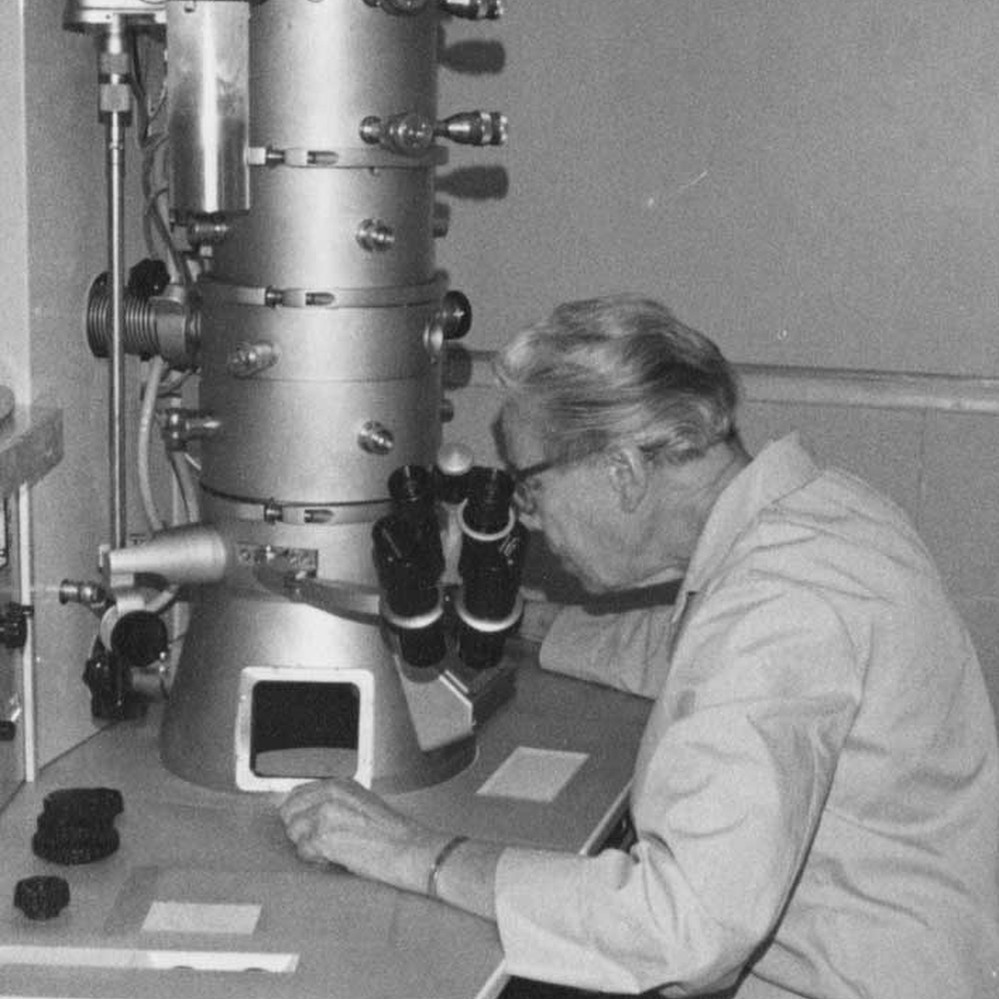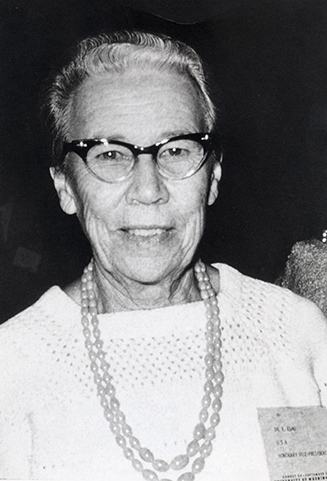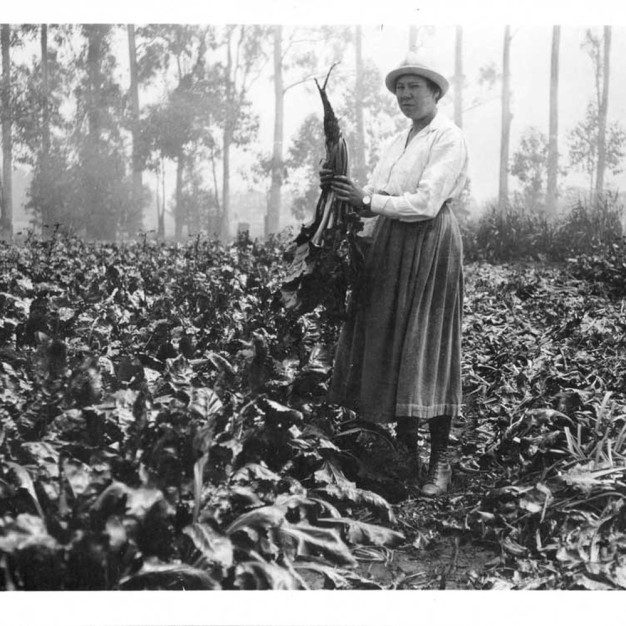Katherine Esau, 1898-1997
Header image: Katherine Esau standing in an Oxnard sugar beet field in 1923. From the Katherine Esau Papers, Department of Special Collections, Davidson Library, University of California, Santa Barbara.
Katherine Esau, a Russian-American botanist elected to the American Philosophical Society in 1964, dominated the field of plant anatomy during a remarkably long and productive career; her achievements set the stage for many modern advancements in plant physiology.
She was born in Ekaterinoslav (now Dnepropetrovsk), Ukraine, in 1898. Her parents, John and Margarethe Esau, were part of a Mennonite religious minority from Germany who sought refuge and land in imperial Russia in the 18th century. Empress Catherine II granted them tracts of land as well as, in deference to their religious pacifism, an exemption from military service for a full century. The Mennonites flourished in their agricultural colonies, and maintained a separate cultural, religious, and linguistic identity.
The Esau family crossed these lines in a number of ways: John was one of the few Mennonites who attended Russian schools, spoke perfect Russian and Ukrainian, and had earned a degree as a mechanical engineer in Riga. Katherine grew up speaking Russian and German with her family. She entered a Russian gymnasium at the age of 11; her family also provided her with private English lessons. Her father, a successful businessman, participated in civic life first as a city council member and then as mayor of Ekaterinoslav. He helped establish the city’s streetcar system and waterworks. His accomplishments and the family’s bilingualism partly shielded them from Russian and Ukrainian resentment of Mennonite isolationism, but they could not stand against the political instability resulting from the Russian Revolution and World War I.
Katherine had enrolled in the Golitsin Women’s Agricultural College in Moscow in 1916, and received high honors for her studies, but she was unable to continue her education once the war came to Russia. The Germans briefly occupied Ekaterinoslav in 1917-1918, but when they retreated, the aftermath for the Esau family was grim. Local Bolshevik revolutionaries declared John Esau, who had remained mayor during the German occupation, to be a counterrevolutionary and “an enemy of the people.” With little time to act, the family gathered what assets and belongings they could and boarded a train with defeated German troops returning to Germany on December 20, 1918. The harrowing journey, which usually would have taken two days, lasted two weeks when the train officials and passengers negotiated (and bribed) their way through areas of Ukraine controlled by assorted revolutionary committees and local bandits. When the Esau family finally reached Germany, they had lost almost all of their possessions.
Fortunately, Katherine and her family had relatives in Berlin who helped them find housing. Katherine, determined not to let circumstances derail her education, enrolled in the Landwirtschaftliche Hochschule, where she earned a diploma in plant sciences. She also received further instruction in English. The family stayed in Germany for three years and then immigrated to the United States. Katherine’s expanding language skills helped them to navigate the interviews at Ellis Island. They then set off for Reedley, California—a town John Esau chose because of its large Mennonite population. Katherine began her employment in California as a housekeeper, though she shortly moved on to manage a seed company. This move prompted her to acquire another language, since she needed to communicate with many of the workers in Spanish. She left the seed company when the Spreckels Sugar Co. of Monterey hired her to improve its production of sugar beets by increasing their resistance to the curly top virus. Katherine’s strong European education in plant genetics served her well in her new job, and she spent long hours under primitive conditions developing the improved sugar-beet.
In 1927, Professor W.W. Robbins, Chairman of the Botany Division at the University of California, Davis (UC Davis), visited Spreckels and was favorably impressed with Katherine’s work. This moment aligned with Katherine’s growing realization that research in the disease resistance of sugar beets would not lead to a permanent career. When she asked Dr. Robbins how she could further research agricultural botany, he immediately gave her an assistantship. Katherine now moved to UC Davis’s campus, but since the university did not have a graduate school, she registered at UC Berkeley.
From the start of her academic career at Davis, she had an ambitious research agenda. Her first hurdle was to prepare for the general examination required of a Ph.D. candidate. Her education in Russia and Germany gave her, according to the dean of the graduate division, the status of Master of Science in California, but she needed an additional three years of intensive scientific training to qualify for the exam. She took the test at the Berkeley campus in 1930 and had no trouble meeting its challenges. Now Katherine could choose the subject of her doctoral research. Her Ph.D. advisory committee assumed that she would base her topic on her work at Spreckels, but she realized that problems came with that choice. Her work on sugar beets at Spreckels included manipulating the leafhopper insects which transferred the disease among plants. Maintaining these insects at UC Davis, due to the constant possibility of their escaping, could endanger the beet crops used for research on the campus.
Katherine responded to this situation by proposing that her original contribution, the necessary component of all Ph.D. theses, should be a comparison of the anatomical structure of normal sugar beets and those infected with the curly-top virus. This appealed to Katherine’s interests more than the original project, but meant that, since Davis had no trained plant anatomists on campus, she would have to apply the necessary knowledge through her own efforts. The resulting manuscript, submitted in 1931, received the unconditional approval not only of Esau’s own advisory committee, but of plant anatomists at other universities. George Ledyard Stebbins, an American botanist and geneticist (APS 1961) who wrote Esau’s APS Biographical Memoir, expanded on how remarkable an achievement this was: “I stand in awe of this extraordinary feat. I have never heard of another candidate who has completed his or her thesis in less than three years after passing the qualifying examination … The success of her lifetime career as a plant anatomist could therefore be predicted from this performance.” After Esau received her doctorate, Prof. Robbins asked her to join the UC Davis faculty.

A prestigious career at UC Davis (she spent most of her tenure in a building with no air conditioning, rumored to have been a garage), cutting-edge research, and publication in plant anatomy, and many awards followed. In the late 1940s Katherine Esau began to write Plant Anatomy, which was published in 1953 to worldwide praise. She promoted understanding of plant pathology through her teaching and the writing of over 150 books and articles. She was tireless: supplementing her research by setting up her own darkroom in her home during her years at UC Davis and meticulously developing photographs of plant structures. She began using the electron microscope for her research first at UC Davis, and later at UC Santa Barbara. The National Science Foundation gave her a grant for an electron microscope solely for her use in 1969. Katherine officially “retired” from her teaching duties in Santa Barbara in 1965. However, she continued her work and published many scientific papers, aided in her research by the linguistics gifts first encouraged by her parents in Ukraine. In her 80s, she bought and taught herself to use a personal computer to aid in her revision of Plant Anatomy. She published her last paper in 1991 at the age of 93.
Her awards and honors include election to the National Academy of Sciences, presidency of the Botanical Society of America, the 11th International Botanical Congress Medal in 1969, and foreign membership in the Swedish Royal Academy of Sciences in 1971. She was the first trained botanist to receive the National Medal of Science in 1989.

Katherine Esau never courted publicity and always emphasized hard work and collaboration with others. She described herself as “mundane,” but her colleagues and students enjoyed the sly sense of humor that accompanied her astute teaching. She died in 1997 at the age of 99. Stebbins concludes: “Her reputation by no means ended with her death, but will live on for many years to come.”
Sources:
- Esau, Katherine. Plant Anatomy. New York: John Wiley& Sons, 1953.
- Notable Women in the Life Sciences: A Biographical Dictionary. Edited by Benjamin F. Shearer and Barbara S. Shearer. Westport: Greenwood Press, 1996.
- Stebbins, George Ledyard, “Katherine Esau (3 April 1898-4 June 1997),” In American Philosophical Society Proceedings, vol.143, no.4. (Philadelphia: American Philosophical Society, 1999) 665-672.

